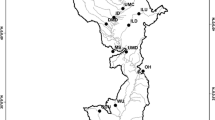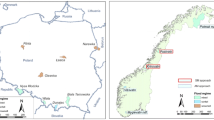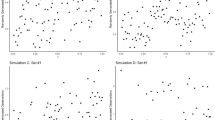Abstract
The MESA-based model, developed in the first paper, for real-time flood forecasting was verified on five watersheds from different regions of the world. The sampling time interval and forecast lead time varied from several minutes to one day. The model was found to be superior to a state-space model for all events where it was difficult to obtain prior information about model parameters. The mathematical form of the model was found to be similar to a bivariate autoregressive (AR) model, and under certain conditions, these two models became equivalent.
Similar content being viewed by others
Abbreviations
- A k :
-
parameter matrix of the bivariate AR model
- B :
-
backshift operator in time series analysis
- eT :
-
forecast error (vector) at timet = T
- ε t :
-
uncorrelated random series (white noise)
- F k :
-
forward extension matrix of the entropy model forkth lag
- I :
-
identity matrix
- m :
-
order of the entropy model
- N :
-
number of observations
- P :
-
order of the AR model
- Q p :
-
peak of the direct runoff hydrograph
- R :
-
correlation matrix
- t p :
-
time to peak of the direct runoff hydrograph
- ν 1 :
-
coefficient of variation
- ν 2 :
-
ratio of absolute error to the mean
- \(\hat x_i\) :
-
forecasted runoff
- x i :
-
observed runoff
- \(\bar x_i\) :
-
mean of the observed runoff
- X −1 :
-
inverse ofX matrix
- X*:
-
transpose of theX matrix
- AIC:
-
Akaike information criterion
- AR:
-
autoregressive (model)
- AR(p):
-
autoregressive process of thepth order
- ARIMA:
-
autoregressive integrated moving average (model)
- acf:
-
autocorrelation function
- ccf:
-
cross-correlation function
- FLT:
-
forecast lead time
- MESA:
-
maximum entropy spectral analysis
- MSE:
-
mean square error
- STI:
-
sampling time interval
References
Akaike, H., 1876, Canonical correlation analysis of time series and the use of an information criterion, in R. Mehra, and D. G., Lainiotis (eds.),Advances and Case Studies in System Identification, Academic Press, New York, pp. 27–96.
Bras, R. L. and Rodriguez-Iturbe, I., 1985,Random Functions and Hydrology, Addison-Wesley, Reading, Mass.
Cooper, D. M. and Wood, E. F., 1982, Identification of multivariate time series and multivariate input-output models,Water Resour. Res. 18(4), 937–946.
Gosain, A. K., 1984, Intercomparison of real-time highflow forecasting models for Yamuna catchment, unpublished PhD Dissertation, Indian Institute of Technology, Delhi, India.
Priestley, M. B., 1989. System identification, Kalman filtering and stochastic control, in D. R. Brilinger and G. C. Tiao (eds.),Directions in Time Series, Institute of Mathematical Statistics, pp. 188–218.
World Meteorological Organization (WMO), 1975, Intercomparison of conceptual models used in operational hydrologic forecasting, Operational Hydrology Report No. 7, Secretariat of WMO, Geneva, Switzerland.
Author information
Authors and Affiliations
Rights and permissions
About this article
Cite this article
Krstanovic, P.F., Singh, V.P. A real-time flood forecasting model based on maximum-entropy spectral analysis: II. Application. Water Resour Manage 7, 131–151 (1993). https://doi.org/10.1007/BF00872478
Received:
Accepted:
Issue Date:
DOI: https://doi.org/10.1007/BF00872478




